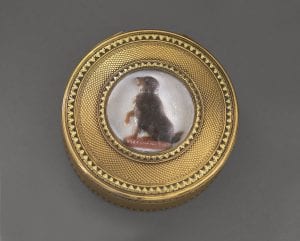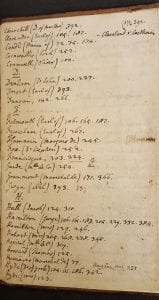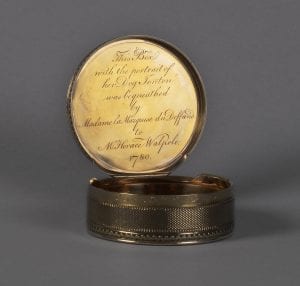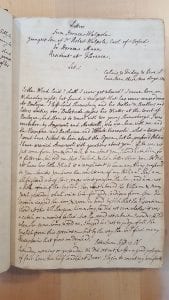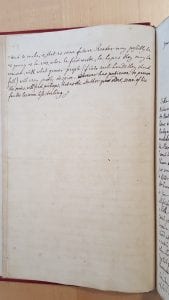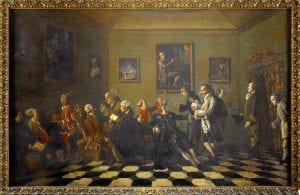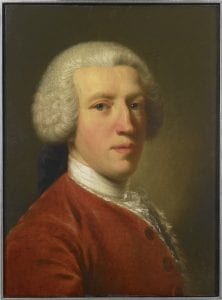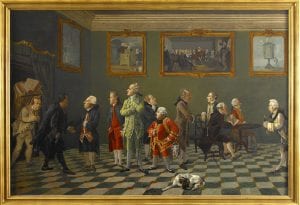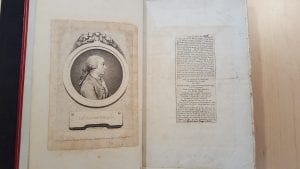27. Walpole’s X
by Sean Silver, Associate Professor, English Language and Literature, University of Michigan
I’d like to write a bit about the letter X—one X in particular, but also the shape of the letter in general. It’s not a popular letter. It is sort of stashed away at the end of the alphabet; we mostly use it when we mean to refuse something else. We say that we “X” or “cross” something out. We “exclude” it, “ex-“ being the Greek prefix for “out,” like exile, exit, or exotic. And we use X’s in this way. John Locke used to cancel pages of his manuscript notes with a large “X,” stretching its limbs from corner to corner. Pages so marked are obsolete, or have been copied elsewhere, thereby excluded from the current pages of his thought. As I look out the window of my hotel room, which happens to be on a busy street, I count no fewer than three x’s, instructing us not to smoke, not to litter, and not to park.
It isn’t that an X isn’t elegant, in its own way. Alexander Pope loved X’s—I mean syntactically or as a rhetorical choice rather than a letter. The Greek X is pronounced Chi. It has been used to abbreviate the name of the Son of God: Chi for Christ. (This also had the virtue of reminding us, ideogrammatically, of the Cross.) But it was also, in Pope’s moment, used to name a certain kind of poetic crossing, where ideas are made to reflect one another, or to cross on the page. So begins his Rape of the Lock with a sort of puzzle or question, almost brought to a paradox by the magic of the cross-like Chi:
Say what strange motive, Goddess! could compel
A well-bred lord t’ assault a gentle belle?
O say what stranger cause, yet unexplor’d,
Could make a gentle belle reject a lord?
In tasks so bold, can little men engage,
And in soft bosoms dwells such mighty rage?
You don’t have to squint too hard to see it. It is a kind of country-dance of ideas, a crossing or a passing on the page: the well-bred lord who assaults the gentle belle; the gentle belle who rejects the lord. If we were to put these lines on the chalkboard, which, in lectures to my undergraduates, I generally do, we draw the x that associates ideas, linking lord to lord, belle to belle. “We call this chiasmus,” I say, “for the Greek letter X”, then I spell “Chiasmus.” In case you didn’t see what Pope was up to, he does it again in the very next couplet. A bold task finds its echo in a mighty rage—which is tucked away in the opposite corner of the following line; “little men” are crossed with “soft bosoms,” in what seems to me to be a summary repetition of the chiastic pairing of lords and belles. There is ideological work happening, here: a philosophical contrapposto or exchange. Its figure is the letter X.
The thing about the X is that it is the simplest letter of two strokes: two bare lines made to cross. As a letter, it is almost unnecessary. Turkish, for instance, dispenses with it altogether; in Istanbul, you hail a Taksi. But as an ideogram, it seems to me to be indispensable, as a sign of emphasis or cancellation. A single line might be an accident; two lines, crossed, define a point and a plane. Something new, in short, happens when two lines are made to meet. This is precisely because it is the most primitive woven letter, where elements are not stacked, but crossed; it is for this reason that William Petty, in his Early Modern treatise on textiles, describes the crucial element of any woven good as the “little X’s” that are made on the loom. A single fiber: it might have tensile strength and possibly some other bare qualities. But with an X, other qualities begin to emerge, like elasticity, or softness. So, too, with the letter itself, which connects and complicates, or, in Petty’s moment, makes “complex.”
This brings me to a somewhat more prosaic, somewhat more tendentious chiasmus, which is suggested by a remark in an appendix in the Yale edition of Walpole’s Correspondence. The appendix refers to Horace Walpole’s letter to Horace Mann of 28 January, 1754. This letter, the editor writes, “inspired more inquiries [to the staff of the LWL] than all the other passages of the Walpolian correspondence put together.” This is a curiosity, but not a crossing; the other half of the chiasmus is this: Walpole, for this passage alone, remains among the most-cited eighteenth-century men of letters in publications on the sciences. People at the Walpole are hearing from science writers for a certain passage in Walpole’s letters; Walpole, for this passage alone, is appearing in their work as a representative of his age. What is more, the passage remains important because it, itself, names a kind of crossing; it gives a name to a species of transformative event, when we come across something we didn’t know we were looking for. It is the very passage where Walpole coins serendipity.
“Serendipity” is a word which is paradoxical in a special way that Walpole perfected. A serious word of deliberate lightness, it names moments where we find what we didn’t know we were looking for. Put more sharply: we go into the world looking for one thing, but, in the looking, find something that we could not have known to want before we started the search. It is transformative in a transformative way; we think that we are accumulating knowledge like a bag accumulates marbles or a book accumulates print: bag and book are untouched by the contact. But, in fact, we are learning learn in the way that a sculptor shapes clay, in which clay and sculptor undergo continuous change. In other words, it isn’t just that the discovery changes the search; it changes the searcher, for what we have found has transformed the way we imagine the world. This is what makes it chiastic, like a letter x. The transformation runs both directions. “Serendipity,” therefore, names two things: we go out into the world, seeking one thing; the world, as compensation, transforms the seeker. This is the crucial crossing, the return route where the total project is altered by its accidental success.
Walpole christened “serendipity” in a 1754 letter penned to his longtime friend and correspondent Horace Mann, the British Minister of Florence. He was sending his thanks for a gift he had just received, a portrait of Bianca Cappello Walpole believed to have been painted by Vasari. It was in bespeaking a custom frame for the painting that Walpole made his discovery; the frame was to bear the arms of the Cappellos on one side, and the arms of the Medicis on the other, for the celebrated Bianca Cappello was the second wife of Francesco I de’ Medici, Grand Duke of Tuscany. “À propos,” Walpole writes, “in an old book of Venetian arms” (the very book which is now at the LWL[1]),
there are two coats of Capello, who from their name bear a hat, on one of them is added a flower-de-luce on a blue ball, which I am persuaded was given to the family by the Great Duke, in consideration of this alliance; the Medicis you know bore such a badge at the top of their own arms. This discovery, indeed, is almost of that kind which I call Serendipity.[2]
Appearing on the same page of this book are two versions of the same coat of arms, two caps with blue balls, identical except for a tiny smudge of a fleur-de-lis in the second (and a typographical error, “Capello / Caepllo”). It is a question, in Walpole’s words, of “persuasion”: events and context have caused a detail, the merest blot of color, to bear rhetorical force, convincing him that he is witnessing the sign of a political union. Not quite satisfied with this story, Walpole adds a definition: serendipity is an “accidental sagacity,” for “no discovery of a thing you are looking for comes under this description.” It is, he suggests elsewhere, what you discover when you are “a la chasse of something very different” (31.325). Thus does “Capello’s portrait open,” writes James Lilley, “onto an interlocking, ever-expanding nexus of image, history, and text. It is as if each object in the [collection] ineluctably unfolds its own history, a history that is tied to other images, other places in the text.”[3] This perfectly captures, I think, the magic of serendipity as a fundamental principle of discovery, of where persons and things are made repeatedly to cross in an archive.
You might wonder why Walpole called this sort of discovery “serendipity,” rather than of some other, less whimsical word—and for that, any number of other studies exist, because Walpole tells us himself that the word comes from a Sherlock-Holmesian tale called “The Three Princes of Serendip.” Walpole fancied himself just such a seeker; his whimsy was, I suppose, the metric of his susceptibility to these sorts of transformative moments. It takes “sagacity” to witness a mere “accident,” but experience it as a transformative lesson.
I would like instead to wind up these remarks by sharing my own serendipitous discovery—which bears in a small way on the intellectual history of the concept itself. I had come to the Lewis Walpole Library as the Charles J. Cole Research Fellow in the summer of 2012. My wife was six months pregnant, but we had decided to reserve this month so I could substantially complete research on the last couple of tricky objects for The Mind Is a Collection, a virtual museum of objects people used to model cognitive theories. Horace Walpole’s copy of his own play, The Mysterious Mother, was one of these objects. I was doing what you can do when you have the time, space, and resources for research: during the day, I was reading deeply in Walpole’s letters, and in the archives held at the LWL; at night, I was staying at the Root House, and reading broadly in the history of the fact, which is to say, the idea of facts, of “fact” as a concept which had to be learned. I was reading William Eamon’s Science and the Secrets of Nature, which traces a major part of this history. It was there that I ran across an early modern theory of knowledge-acquisition, in which we discover things by accident. It was commonly compared to a certain kind of hunt, but where we continually happened upon objects we didn’t know we were seeking. It is, Eamon suggested, a form of “accident”; it requires, (he suggests), “sagacity.”
To my ear, this was a clear echo of Walpole. The problem is, Eamon wasn’t quoting Walpole—he was quoting Francis Bacon, or, really, the standard translation of Bacon, which wasn’t made until nearly a century after Walpole’s coinage. How this precise formulation, how it was that Walpole, like Eamon, thought of discovery as “accident” crossing with “sagacity,” became one of the principle projects of the next year or so of my life—happily interrupted by the birth of a beautiful daughter. That story is now in print, and has become useful to people working on the serendipity concept—for it shows us some of the ideas Walpole himself was weaving together when he coined his term.
This drove me back to Walpole’s collection, and to his remarks on serendipity, as I put together the parts of what would become a piece on “The Prehistory of Serenidipity.” But it also drove me to Walpole’s library, to the “old book of Venetian arms,” which against the odds, survived the teeth of time to find its way into Lewis’s collection of Walpole’s books. There, on page 12, are the coats of arms Walpole describes, and, in the margin, a little X, penned there to register the frisson of his discovery. This is of course the X which is the subject of these remarks. Walpole, with his joints not yet suffering from the gout that would cripple him late in life, held open that tightly bound little book, and placed a neat ideogram in the margin. You may still see it there. It is the first serendipitous discovery so-called. It reminds us that an X doesn’t just wipe things out. It also marks a spot: and not just a spot of special note, but a place where a transformation occurred, both in Walpole, but also in theories of discovery.
[1] Le arme overo insegne di tutti le nobili . . . di Venetia (Venice, 1578), p. 12, Lewis Walpole Library, Farmingham, Connecticut, call no. 49 2051. It’s probably worth pointing out at this point that Walpole commonly marked passages suggesting surprising discoveries with a marginal “x.” See, e.g., Walpole’s commonplace book, which he called his Book of Materials (1777), at the Lewis Walpole Library, pp. 6, 27, 29, etc.
[2] Walpole, Correspondence, Vol. 26, p. 307.
[3] James D. Lilley, “Studies in Uniquity: Horace Walpole’s Singular Collection,” ELH 80.1 (2013): 93-124, p. 119.
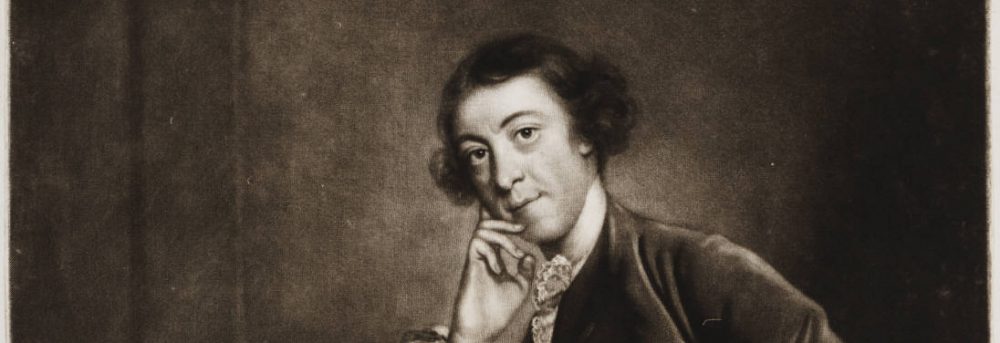

![Duchesse de Choisel, and Madame la Marquise Du Deffand [graphic] : (from the original formerly at Strawberry Hill) / M. Carmontel, del. ; W. Greatbach sculp.](https://campuspress.yale.edu/walpole300/files/2018/07/Mme-du-deffand-29lufgd-199x300.jpg)
